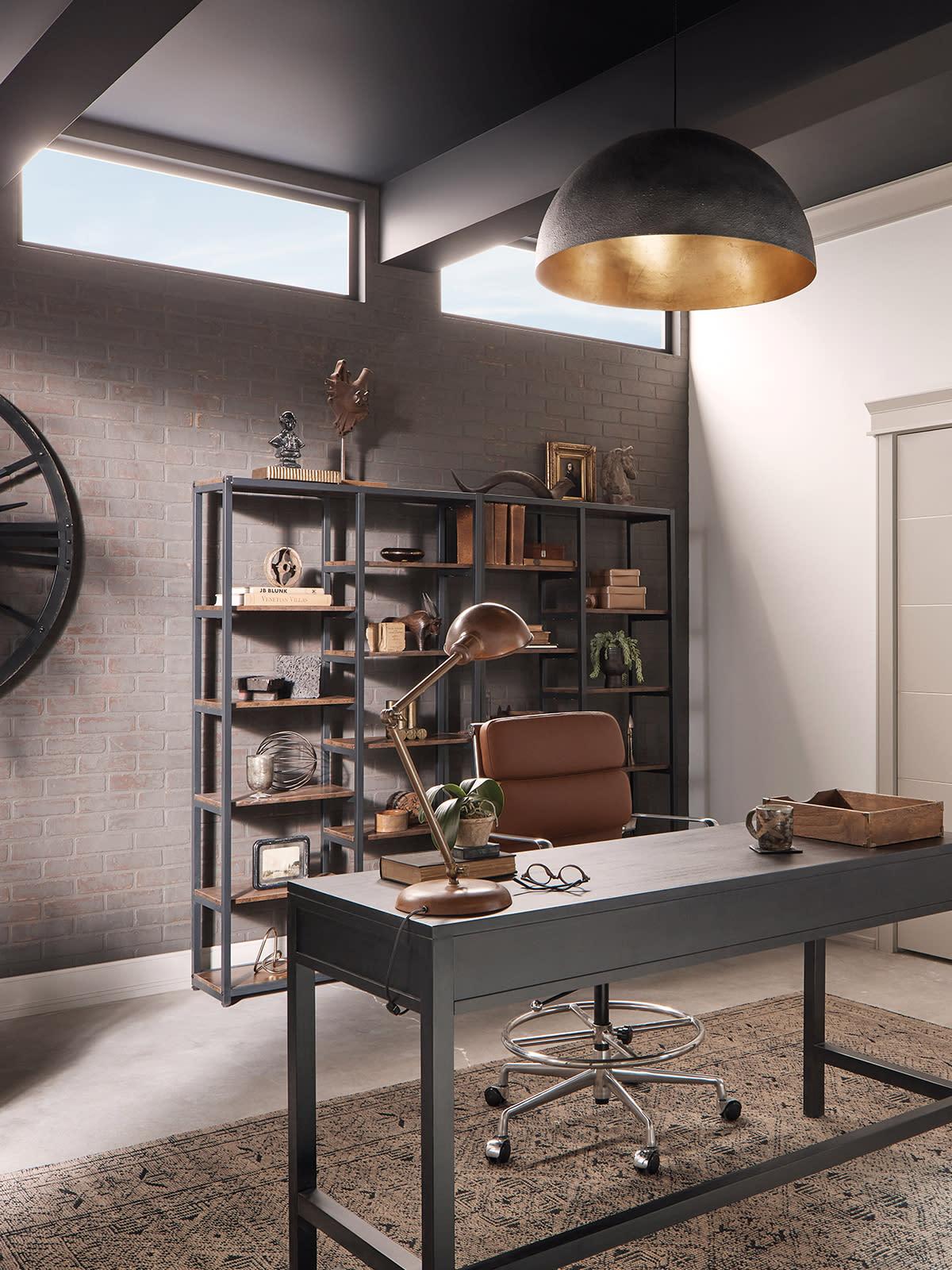How to Achieve a Vintage Industrial Living Room Design
October 10, 2020
By: The Finished Space
The History of Vintage Industrial Design
Following its introduction in the mid-2000s, Vintage Industrial design first started gaining traction from 2007–09 and remained popular through the 2010s. It’s 2020, and there’s no sign of this design’s popularity going away anytime soon.
Influenced by the warehouses and factories of the Industrial Revolution, Vintage Industrial design incorporates man-made, unfinished elements like brick, metal, concrete, and exposed pipes into interior design.
In addition to unfinished, industrial materials, many Vintage Industrial spaces also incorporate leather furniture, wood, and incandescent lighting. While Vintage Industrial designs are known for open spaces, large windows, and unfinished materials, this design style is beloved for its warmth and comfort.
Modern Vintage Industrial Design Elements
Dark, Edgy Colors
Modern Vintage Industrial design often pairs the muted colors in exposed brick and concrete with grays and other neutrals. However, dark, edgy accents create a balance and pull the design together. Leather furniture made from deep, reddish browns complements the redness of exposed brick, while furniture with black or gold metal and wood accents can add rugged warmth.
If you’re looking to add some color to your Vintage Industrial living room, a muted palette of vintage colors—dark reds, blues, and greens—is recommended, as they will blend well with the other colors and textures in your living room.
Metals
Some spaces, like loft apartments, are created with Vintage Industrial design in mind. They often have huge, metal-framed windows and ceilings with exposed pipes or ducts. However, not every space comes with these features.
You can incorporate metals into any living room through light fixtures, lamps, furniture, and decor to create a Vintage Industrial design. Don’t limit yourself to black metals, which are commonly seen in this design trend. You can also look at other options, including gold, copper, and bronze.
Concrete & Exposed Brick
Many houses and apartments are finished with drywall and wood or vinyl flooring. However, contractors have started keeping and restoring original interior features, such as concrete and exposed brick, when renovating old structures into residential spaces.
K-Ann Kreations & Design, Ltd.
Exposed brick is especially popular in urban loft apartments and brings texture and character into the design. As stated before, exposed brick pairs well with reddish-brown leathers and other muted, vintage colors, and can act as a bridge between the cooler tones of concrete and metals.
Concrete floors are also common in these renovated living spaces and are a great foundation for Vintage Industrial design. Leave your concrete floors bare for a stronger, edgier look, or lay down an area rug in vintage colors to add more warmth and color.
Urban & Edgy Unfinished Materials
Vintage Industrial design is heavily influenced by the Industrial Revolution, so it shouldn’t be a surprise that this design trend is popular in urban areas. In fact, many former warehouses and factories are being refurbished into loft apartments, providing city-dwellers with unique, historic places to call home.
This doesn’t mean that you can’t create a Vintage Industrial design living room in the suburbs, but it does mean that many urban areas have a primed foundation for this design trend.
If your home does not have exposed concrete floors or red brick walls commonly found in urban lofts, there are still many elements that you can easily incorporate to replicate these styles. Consider upgrading to black-framed windows and putting down vintage-looking wood floors or tile that resembles concrete.
Geometric Shapes & Sharp Angles
Another feature of Vintage Industrial design that is more subtle than the materials and colors are the geometric, sharp-angled shapes. Use curves sparingly when going for a Vintage Industrial look. Choose furniture with square edges instead of rounded ones. Hang a square or rectangular mirror instead of round, and look for decor with those same sharp angles. Choosing wall art or area rugs with understated geometric shapes is another way to bring these elements into your living room.
Sleek Lines
Even though many of the materials look unfinished, Vintage Industrial design uses sleek, defined lines. Think of the metal-framed windows in loft apartments with their sharp, defined square panes, or of pipes running straight across the ceiling and down a wall.
This element of sleek lines can be incorporated into your finishings and decor choices as well. For example, choosing furniture with clearly defined lines can echo the other sleek lines in the room, such as window trim, baseboards, or molding.
Industrial Pipe Elements
Some loft apartments come with exposed pipes, however, you may want to incorporate industrial pipe elements into your living room in other ways. Light fixtures and furniture created from industrial piping can add to your Vintage Industrial design and serve as a stunning centerpiece in your living room.
Filament Bulbs
As you read earlier, Vintage Industrial design often uses incandescent lighting, which is easy on the eyes and adds warmth and comfort to your space. Exposed, hanging bulbs, such as Edison bulbs, are a popular choice for Vintage Industrial living rooms, as are light fixtures that incorporate filament bulbs.
Achieve a Vintage Industrial Look with Metrie
Metrie can help you achieve the Vintage Industrial design living room of your dreams.
Browse through Metrie Option M for our suggestions on finishings, including crown molding, casing, baseboards, and doors, all created with sleek, clean lines.

